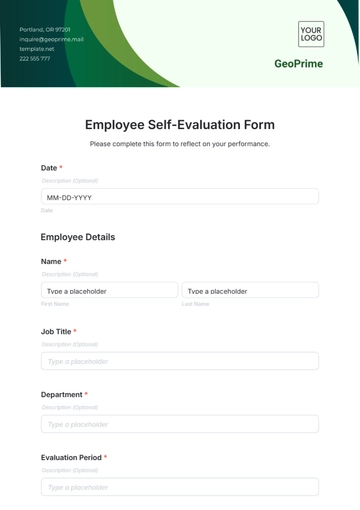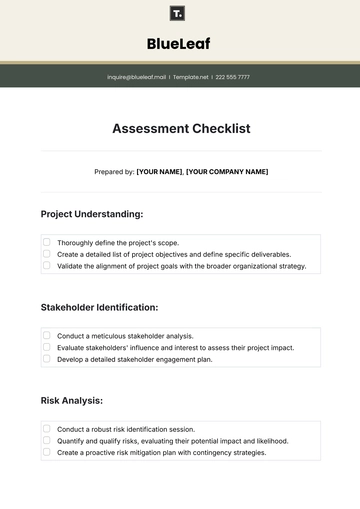Free CEO Risk Assessment

Introduction
The purpose of this Risk Assessment is to evaluate and manage the potential risks associated with the leadership and strategic decisions made by the Chief Executive Officer (CEO) of [Your Company Name]. The risk assessment provides a comprehensive evaluation of the CEO's role and the associated risks, which could impact the long-term sustainability, reputation, and financial health of the company.
1. Financial Risks
1.1 Revenue Generation Risks
The CEO's decisions regarding revenue models, pricing strategies, and market expansion are critical to maintaining sustainable growth. If the CEO’s strategic vision does not align with market trends, there is a risk of reduced sales and profitability. This includes decisions about product launches, investment in new markets, and financial forecasting.
Potential Impact: A [10%] decrease in revenue could lead to a loss of [$5,000,000].
Mitigation Strategy: The CEO should establish strong financial oversight mechanisms, regularly review the performance against financial goals, and adjust strategies based on real-time market data.
1.2 Cost Control and Efficiency
Poor decision-making in cost management, such as overspending on unprofitable ventures or failing to optimize operational costs, may result in unsustainable cash flow. The CEO’s ability to implement efficient systems is key to profitability.
Potential Impact: Operational cost overrun could lead to a [5%] deficit in the budget, equaling [$1,000,000].
Mitigation Strategy: Ensure robust budgeting and forecasting practices are in place, and implement a strict review of expenses and investments.
2. Strategic and Operational Risks
2.1 Business Model Adaptability
The CEO is responsible for ensuring the business model adapts to changing industry conditions and market disruptions. If the company fails to innovate or pivot when necessary, there is a risk of losing competitive advantage.
Potential Impact: Failure to innovate could result in a loss of market share, leading to a decrease in valuation by [$20,000,000].
Mitigation Strategy: The CEO should prioritize continuous research and development, and maintain agility in the company’s operational and strategic planning.
2.2 Leadership and Team Cohesion
Effective leadership and the ability to maintain a motivated and cohesive executive team is critical for the overall success of the company. A disconnect between the CEO and key executives could lead to a loss of talent and operational inefficiency.
Potential Impact: High turnover rates could result in significant recruitment and training costs, potentially costing [$500,000].
Mitigation Strategy: Implement regular leadership training, team-building activities, and a transparent communication strategy.
3. Reputational Risks
3.1 Public Perception
The CEO’s actions, public statements, and personal conduct can significantly impact the company’s reputation. Scandals, ethical missteps, or unpopular decisions made by the CEO could cause lasting damage to the company’s brand.
Potential Impact: A reputational crisis could lead to a [25%] decline in customer trust, resulting in a loss of market value by [$15,000,000].
Mitigation Strategy: Maintain a high standard of personal conduct and ensure transparency with stakeholders. Engage in regular public relations efforts to safeguard the company's image.
3.2 Stakeholder Engagement
A lack of alignment with key stakeholders (investors, customers, partners) due to poor communication or strategic divergence can lead to discontent or withdrawal of support.
Potential Impact: Loss of investor confidence could lead to a reduction in stock price by [10]%, potentially decreasing company value by [$10,000,000].
Mitigation Strategy: Foster consistent and effective communication with all stakeholders, and make strategic decisions that align with their interests and expectations.
4. Legal and Compliance Risks
4.1 Regulatory Compliance
The CEO is responsible for ensuring that the company operates within legal and regulatory frameworks. Non-compliance with laws and regulations could lead to costly fines, legal proceedings, and reputational damage.
Potential Impact: Legal liabilities could lead to fines or settlements costing [$2,000,000].
Mitigation Strategy: Establish a compliance team to monitor and enforce adherence to legal and regulatory standards, and provide regular training for executives and staff.
4.2 Contractual and Partnership Risks
The CEO plays a key role in negotiating contracts with partners, suppliers, and clients. Poorly structured or unfavorable agreements can expose the company to financial or legal risks.
Potential Impact: A high-risk partnership could result in significant financial penalties or contract cancellations, costing [$1,500,000].
Mitigation Strategy: Engage legal counsel in all major negotiations and establish a review process to ensure the terms of contracts align with the company’s best interests.
5. Market and External Risks
5.1 Economic Downturns
The CEO must be prepared for the impact of macroeconomic factors such as recessions, inflation, and changes in government policy, which could significantly affect company performance.
Potential Impact: A global recession could lead to a revenue decline of [15%] and cause a drop in company value by [$25,000,000].
Mitigation Strategy: Develop contingency plans, including diversifying revenue streams and reducing operational costs during economic downturns.
5.2 Technological Disruptions
The rapid pace of technological advancements presents both opportunities and threats. Failure to adapt to new technologies or invest in innovation could make the company obsolete in the face of new industry trends.
Potential Impact: Technological obsolescence could result in a [20%] reduction in market share, translating into a [$10,000,000] loss.
Mitigation Strategy: Invest in ongoing technology assessments and strategic partnerships to ensure the company remains competitive in a fast-changing market.
6. Conclusion and Risk Management Strategy
To mitigate these identified risks, the CEO of [Your Company Name] must maintain a strong risk management framework, establish clear communication channels, and regularly assess both internal and external factors that could affect the company's operations. By proactively managing these risks, the CEO can ensure the long-term success and sustainability of the company.
Contact Information:
[Your Name]
[Your Title]
[Your Company Name]
[Your Company Email]
- 100% Customizable, free editor
- Access 1 Million+ Templates, photo’s & graphics
- Download or share as a template
- Click and replace photos, graphics, text, backgrounds
- Resize, crop, AI write & more
- Access advanced editor
Identify and manage potential risks with the CEO Risk Assessment Template from Template.net. This editable and customizable template helps you assess and mitigate risks effectively. Use the AI Editor Tool to tailor it to your needs. Download today to protect your business from unforeseen challenges.





























